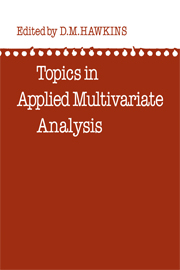Book contents
- Frontmatter
- PREFACE
- CONTRIBUTORS
- Contents
- CHAPTER 1 DISCRIMINANT ANALYSIS
- CHAPTER 2 COVARIANCE STRUCTURES
- CHAPTER 3 THE LOG-LINEAR MODEL AND ITS APPLICATION TO MULTIWAY CONTINGENCY TABLES
- CHAPTER 4 SCALING A DATA MATRIX IN A LOW-DIMENSIONAL EUCLIDEAN SPACE
- CHAPTER 5 AUTOMATIC INTERACTION DETECTION
- CHAPTER 6 CLUSTER ANALYSIS
- INDEX
CHAPTER 1 - DISCRIMINANT ANALYSIS
Published online by Cambridge University Press: 05 November 2011
- Frontmatter
- PREFACE
- CONTRIBUTORS
- Contents
- CHAPTER 1 DISCRIMINANT ANALYSIS
- CHAPTER 2 COVARIANCE STRUCTURES
- CHAPTER 3 THE LOG-LINEAR MODEL AND ITS APPLICATION TO MULTIWAY CONTINGENCY TABLES
- CHAPTER 4 SCALING A DATA MATRIX IN A LOW-DIMENSIONAL EUCLIDEAN SPACE
- CHAPTER 5 AUTOMATIC INTERACTION DETECTION
- CHAPTER 6 CLUSTER ANALYSIS
- INDEX
Summary
PRELIMINARIES
General Introduction
Discriminant analysis is concerned with the problem of classifying an object of unknown origin into one of two or more distinct groups or populations on the basis of observations made on it. As evidenced by the examples given below, this problem occurs frequently in various fields as diverse as medicine, anthropology and mining, and the techniques of discriminant analysis have been used successfully in many situations. Computer packages for performing the necessary calculations involved in applying some of the techniques have been readily available for some time, although there are still some serious omissions in most of these packages.
Some examples
1. Haemophilia is a sex-linked genetic disease which is transmitted only by females, but whose symptoms are manifest only in males. Under normal medical examination it is impossible to distinguish between females carrying the disease and those not. In order to try and identify female carriers, the levels of a coagulant factor and its related antigen (Factor VIII and Factor VIII RA) in the blood have been suggested as possible discriminators between carriers and non-carriers.
A pilot study was carried out by Gomperts et al (1976) to test how well Factor VIII and its related antigen discriminate between carriers and non-carriers. A sample of 26 white females, of which 11 were known, for genetic reasons, to be carriers and 15 were known to be non-carriers was selected and the Factor VIII and Factor VIII RA levels measured in each subject.
- Type
- Chapter
- Information
- Topics in Applied Multivariate Analysis , pp. 1 - 71Publisher: Cambridge University PressPrint publication year: 1982
- 14
- Cited by



